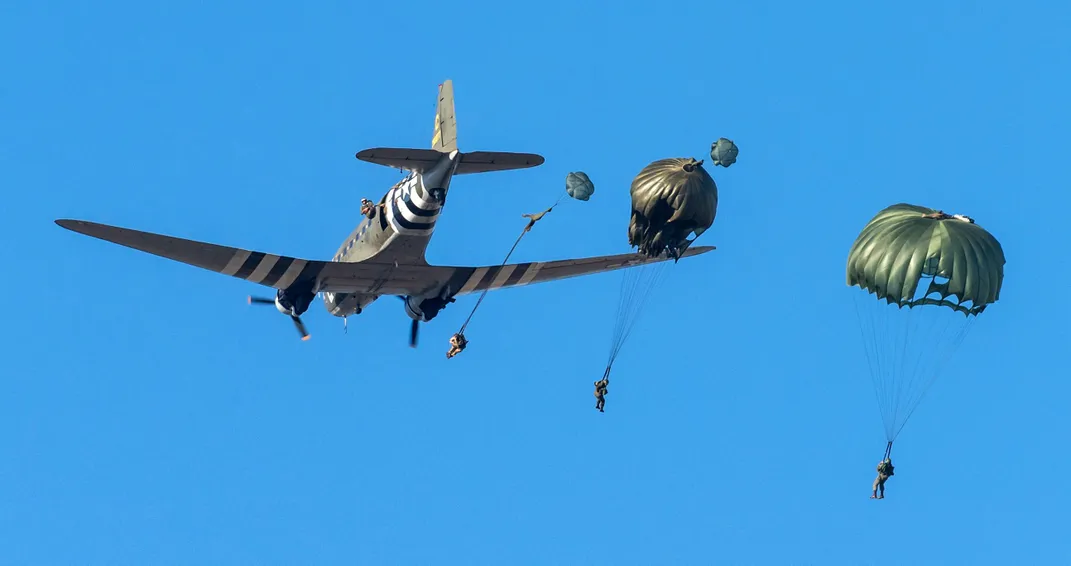Jumping Into the Past With the World War II Airborne Demo Team
The year was 2019, but to us it felt more like 1944.
/https://tf-cmsv2-smithsonianmag-media.s3.amazonaws.com/filer/65/1e/651ecd5b-9c2b-4bb4-9412-dac302655aea/17e_dj2021_mitchatjumpschool_john_bell_ll__dsc8683_live.jpg)
The sun was rising over the airfield as we donned our parachutes inside the hangar.
Chest strap first. Then leg straps. Waistband through loops on the reserve parachute. Reserve parachute attached to the jump harness. Waistband pulled tight and secured. Right hand over the reserve ripcord grip. Ready for inspection.
After the jumpmaster approved my gear, I joined the other members of my “stick” (meaning the group who would be jumping from the same aircraft into the same drop zone) by the hangar door. Dressed in brown jump boots, green fatigues, and steel helmets secured with leather chinstraps, we watched our C-47 Skytrain crank its engines. Today we would make our first jump.
The year was 2019, but to us it felt more like 1944—by design. We were in Frederick, Oklahoma at the World War II Airborne Demonstration Team’s summer jump school to live the demo team’s motto: to remember, honor, and serve the American troops who fought in World War II.
The ADT is a nonprofit living history organization. Three times a year they run a jump school, certified by the Federal Aviation Administration. Students train, eat, and sleep in the World War II-era hangar that still bears the name “Frederick Army Airfield.” The hangar also houses the C-47 jump aircraft Boogie Baby, the rigger shop, parachute packing tables, barracks, offices, laundry room, and latrines. It’s all under one (huge) roof.
I came here as a retired soldier to pay tribute to my forebears. I’ve known veterans of the D-Day jump into Normandy and Jedburgh paratroops from the Office of Strategic Services—my special operations forefathers. Attending an immersive World War II parachute training program was my way of commemorating their service and sacrifice.
I’d retired as a lieutenant colonel, so I found it both nostalgic and humbling to be told for the first time in many years how to make my bed, what time to get up, and when to “fall in” every morning. Training days typically run from 5:30 a.m. to 10:00 p.m. at the Parachute School. They must. The ADT is teaching in nine days what Uncle Sam does in three weeks at Fort Benning, Georgia.
The week was filled with classroom instruction on how a parachute works, parachute landing falls, and emergency procedures while suspended in a harness. We also used a mock-up of the C-47 to practice the proper way to exit the airplane. After dinner, students performed KP duty in the chow hall, swept the barracks, or cleaned the latrine. The few free minutes before lights out were reserved for spit-shining jump boots, studying for must-pass exams, or a quick call home.
“Jumpers circle up!” yelled retired Colonel Ray Steeley, senior officer of the ADT. The command snapped us out of our private reveries back into the here and now. Colonel Steeley led a prayer for a safe jump, told us to rely on our training, and wished us luck.

Boogie Baby had been built in 1942 about 150 miles from this hangar, in Oklahoma City. In the decades since the troop carrier had been decommissioned, it had flown for a number of air forces, most recently Israel’s. Since coming home to Oklahoma, the C-47 had been restored and painted in the livery of the 441st Troop Carrier Group, 301st Troop Carrier Squadron. As I gripped the edges of the jump door to climb into the aircraft, I thought about the men who’d hauled themselves up into other C-47s on June 5, 1944, and the fear they must have felt along with their sense of duty.
Through the open door I watched the tarmac race past. I had a lump in my throat. My eyes watered. That thing was happening—the feeling you get when you reflect on, understand, and appreciate what you have; how you came to have it; who gave it to you. I felt them. Those men, most of them now dead, were with us.
“Six minutes!” shouted jumpmaster Keith Harriott. After this advisory came commands: Stand up! Hook up! Sound off your equipment check! We passed our “OK!” down the line to the jumper closest to the door, who loudly reported “All OK jumpmaster!” to Harriott.
He looked out the door over the shoulder of the kneeling spotter, both confirming the location of the release point on the drop zone. Harriott raised a finger and shouted “One minute!” over the rushing wind and drone of the engines. Then, just like you see in the movies, the jump light near the door went from red to green.
“Stand in the door!” commanded Harriott to the first jumper, who braced his hands on the outside of the door, put his right foot forward, and flexed his knees. It was about to happen.
“Go!” barked Harriott. The first jumper stepped out and disappeared from sight. The rest of us filed to the door, guiding our static lines along the anchor cable.
Jumpers vanished in front of me, and in seconds, it was my turn. I passed my static line to Harriott, made a hard turn to the right, reached, stepped, exited, and was immediately blasted by the hot prop wash as I began falling toward the ground.
I counted aloud to four as I’d been trained by the Army and then again, years later, by the ADT and felt the violent yet welcome shock of my parachute opening before I reached the “uh-oh” count of “five-one-thousand.” Everything was now quiet as I checked the canopy over my head, turned into the wind, and watched for other jumpers. We were all drifting backward.
The serenity didn’t last long. I was descending at over 18 feet per second and we’d jumped from 1,500 feet. I couldn’t help wondering how hard that sunbaked dirt field was going to be.
I focused on the horizon, prepared to land and…BAM! I had executed a semi-gymnastic dismount from the sky. Graceful my touchdown was not. But I experienced no snaps, crackles, or pops. No ringing bells or short naps. “Infiltration complete,” a younger version of myself thought.
I gathered my gear and moved to the assembly area to continue the mission to remember, honor, and serve our World War II veterans.
